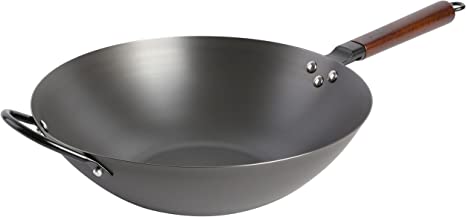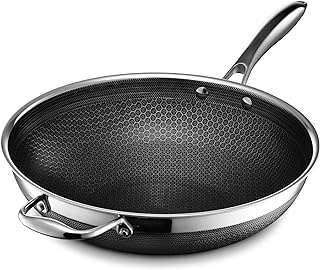Round Bottom vs Flat Bottom Wok: Which is Right for You?

Are you a cooking enthusiast looking to level up your stir-fry game? Choosing the right wok can make all the difference in achieving those perfectly cooked, flavorful dishes. But with so many options available, it can be overwhelming to decide between a round bottom vs flat bottom wok. In this blog, we will break down the characteristics of each type and help you determine which one is right for you. We’ll explore the advantages and disadvantages of both round bottom vs flat bottom wok, discuss their differences in heat distribution, and provide tips on choosing the best option for your kitchen setup. By the end of this blog, you’ll have all the information you need to make an informed decision and start wokking like a pro!
Understanding the Round Bottom Wok
The round bottom wok is a traditional Chinese cooking utensil specifically designed for stir-frying. With its rounded shape, it allows for easy tossing and flipping of ingredients, promoting even cooking throughout the dish. However, it’s important to note that round bottom woks require a wok ring or specialized stove setup for stability. This is because the curved surface doesn’t sit securely on a flat cooking surface.
Made from materials such as carbon steel or cast iron, a carbon steel wok or round bottom wok offers excellent heat retention, distributing heat evenly and efficiently. This enables quick cooking, ideal for stir-fries, deep-frying, boiling, and other versatile cooking techniques. The high heat capacity and well-distributed heat of a round bottom wok create the coveted “wok hei,” a smoky flavor imparted by the intense heat.
The Advantages and Disadvantages of Round Bottom Wok
 | Babish Carbon Steel Flat Bottom Wok and Stir Fry Pan, 14-Inch |
Round bottom woks offer several advantages in Asian cooking. Their curved shape allows for easy tossing and flipping of ingredients, making them ideal for stir-frying. Additionally, round bottom woks distribute heat evenly, ensuring that food cooks quickly and uniformly. However, there are some disadvantages to consider. Round bottom woks require a wok ring or specialized stove setup to stabilize them during cooking, which may not be suitable for flat surface stoves. Furthermore, their shape can make cleaning more challenging. Despite these drawbacks, many home cooks appreciate the traditional nature and versatility of round bottom woks, making them a popular choice for stir-fries, braising, and even steaming. With proper care and usage, a round bottom wok can be a durable and essential piece of cookware in any kitchen.
Exploring the Flat Bottom Wok
The flat bottom wok offers several advantages over its round-bottom counterpart. It is particularly well-suited for electric and induction stoves, as it provides better heat distribution and stability on flat surfaces. This makes it easier to use and maneuver, especially for beginners. The flat bottom design also allows for a larger cooking surface area, accommodating more ingredients and ensuring even cooking. Despite these benefits, some chefs still prefer the traditional shape of the round bottom wok, as it excels at stir-frying at high temperatures. Ultimately, the choice between round bottom vs flat bottom wok depends on personal preference and the specific needs of the cook.
The Pros and Cons of Flat Bottom Wok
 | Helen's Asian Kitchen Helen Chen's Asian Kitchen Flat Bottom Wok, Carbon Steel with Lid and Stir Fry Spatula, Recipes Included, 13.5-inch, 4 Piece Set, 13.5 Inch, Silver/Gray/Natural |
Flat bottom woks, such as the flat-bottomed wok, have their advantages and disadvantages. One of the main advantages is that they are designed to be used on electric or flat stovetops, making them more versatile for different types of kitchens. The larger cooking surface area of a flat bottom wok allows for more even heat distribution, resulting in better searing and stir-frying. Additionally, flat bottom woks, such as the flat-bottom wok, are generally easier to handle and maneuver compared to their round bottom counterparts. They provide stability on the stove, reducing the risk of tipping or spilling. However, it’s important to note that flat bottom woks may not retain heat as well as round bottom woks, which can affect the taste and texture of certain dishes.
How do Round Bottom and Flat Bottom Woks Differ?

Round bottom vs flat bottom woks differ in terms of their traditional use, stability, versatility, and heat distribution. While round-bottomed woks require a specialized stove for stability and heat up quickly with even heat distribution, flat bottom woks are more versatile and can be used on any type of stovetop. The choice between the two depends on your cooking style and kitchen setup.
Discussing Heat Distribution
When it comes to heat distribution, round bottom vs flat bottom woks have their own unique characteristics. Round bottom woks, traditionally used in Chinese cooking, are designed to be used on a wok ring or gas burner. Their curved shape allows for even heat distribution, making them ideal for quick and efficient stir-frying. On the other hand, flat bottom woks are more versatile and can be used on electric or induction stovetops. However, they may have hot spots and uneven heat distribution, which requires more frequent stirring and adjusting of ingredients. Ultimately, the choice between a round bottom vs flat bottom wok depends on the type of stove you have, your cooking style, and personal preference.
Making the Right Choice for Your Kitchen
When it comes to choosing between a round bottom wok vs flat bottom wok, there are a few factors to consider. Round bottom woks are traditional and versatile, making them ideal for stir-frying and tossing ingredients. They require a wok ring or specialized burner for stability on a flat stovetop. Flat bottom woks, on the other hand, are more stable on modern stovetops and better suited for Western-style cooking. They are easier to clean and can be used on various heat sources, including induction stoves. Ultimately, the choice between round bottom vs flat bottom wok depends on your cooking preferences and the type of stove you have. It’s important to consider these factors along with your kitchen setup and personal preference to make the right choice for your kitchen.
Which Wok Works Best for Different Types of Burners?
 | YOSUKATA Flat Bottom Wok Pan - 13.5" Blue Carbon Steel Wok - Preseasoned Carbon Steel Skillet - Traditional Japanese Cookware - Carbon Steel Pan for Electric Induction Cooktops Woks and Stir Fry Pans |
When it comes to choosing the right wok for your kitchen, considering the type of burner you have is crucial. Round bottom woks are ideal for gas burners, while flat bottom woks, such as electric stoves, are better suited for electric and induction cooktops. Optimize your cooking performance by matching the wok to your burner type.
Considerations Beyond the Shape: Material, Size, and Handles
When choosing between a round bottom vs flat bottom wok, it’s important to consider factors beyond just the shape. Material plays a crucial role in heat distribution and retention. Carbon steel and cast iron are popular choices, with each offering its own advantages. Additionally, size is an important consideration. The size of your stovetop and the amount of food you typically cook will determine the right wok size for you. Handles are another aspect to think about. You can choose between a wok with one long handle or two short handles based on your preference for easier handling. Moreover, your cooking style should be taken into account. If you prefer stir-frying or deep-frying, you’ll want to choose a wok shape that suits your needs. Finally, maintenance is a crucial factor. Some woks require seasoning and regular upkeep, so consider the level of care you’re willing to put into your wok choice.
How to Maintain and Care for Your Wok?
To maintain and care for your wok, start by seasoning it before the first use. After each use, wash it with warm water and mild detergent, avoiding abrasive cleaners. Dry it thoroughly to prevent rusting and store it in a dry place.
Frequently Asked Questions

What is the advantage of a round bottom wok?
Round bottom woks offer several advantages. They are ideal for traditional Chinese cooking techniques like stir-frying and tossing. These woks distribute heat evenly, resulting in quick and efficient cooking. Their curved shape requires less oil, making them a healthier option. Additionally, round bottom woks are lighter and easier to handle compared to flat bottom woks.
Do round bottom woks work on gas stoves?
Traditionally designed for gas stoves, round bottom woks provide better heat distribution and are ideal for stir-frying. However, you’ll need a wok ring or stand to stabilize them on a gas stove. Flat bottom woks are more compatible with electric and induction stoves.
Conclusion
 | HexClad 12 Inch Hybrid Stainless Steel Wok with Stay Cool Handle, Dishwasher and Oven Safe, Works with Induction, Ceramic, Non-Stick, Electric, and Gas Cooktops |
After weighing the advantages and disadvantages of both round bottom vs flat bottom wok, it’s clear that the right choice ultimately depends on your specific needs and kitchen setup. Consider factors such as heat distribution, compatibility with different types of burners, material, size, and handle design when making your decision.
Remember to also take into account the maintenance and care required for each type of wok to ensure its longevity and optimal performance. Whether you choose a round bottom vs flat bottom wok, with the right technique and seasoning, you can create delicious stir-fries and Asian-inspired dishes in the comfort of your own kitchen.
If you’re still unsure which type of wok is right for you, reach out to our experts who can provide personalized recommendations based on your unique requirements. Don’t settle for anything less than the perfect wok that will elevate your culinary skills. Contact us now for a free consultation or visit our website to explore our wide range of high-quality woks.



